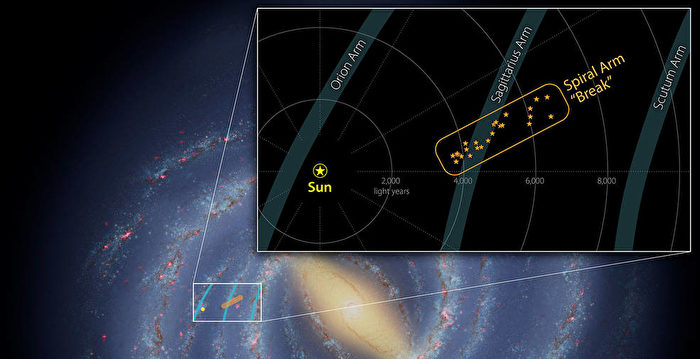[Epoch Times August 22, 2021]For astronomers, the Milky Way is both the most familiar and strangest galaxy. Since our Sun and Earth are located near the inner edge of one of the spiral arms of the Milky Way (called the Orion Arm), we can see many details near us, including many stars and their planets. However, it is difficult for us to observe the whole picture of the Milky Way as a whole because “I don’t know the true face of Mount Lu, but we are only in this mountain.”
Recently there has finally been a major breakthrough in this area. According to a statement issued by NASA on August 17, using NASA’s Spitzer Space Telescope and the European Space Agency’s (ESA) Gaia Mission, a team of astronomers successfully mapped A three-dimensional map of the star-forming regions and their velocities in a spiral arm called the Sagittarius arm was created.
Surprisingly, there is a fault on this spiral arm.
Michael Kuhn, an astrophysicist at the California Institute of Technology and the lead author of the new paper, said in a statement: “A key feature of spiral arms is the degree to which they wrap around the galaxy.” This can be achieved by the arm. The pitch angle is measured.
In galactic astronomy, the pitch angle refers to the angle between the spiral arm and the tangent of the circle. In this way, a perfect circle has no pitch angle, and if the swing arm is opened, the pitch angle becomes larger.
Kuhn added in the aforementioned statement: “Most models of the Milky Way show that the Sagittarius arms form a spiral with an elevation angle of about 12 degrees, but some of the structures we observe protrude at an angle of nearly 60 degrees.”
The Sagittarius arm is a well-observed spiral arm in the Milky Way. It contains several star-forming regions, including the famous Pillar of Creation.
To further understand this spiral arm, the research team combined Gaia and Spitzer data to map the three-dimensional position and velocity of a part of the star-forming region of the Sagittarius arm.
“When we put the Gaia and Spitzer data together and finally saw this detailed three-dimensional sky map, we can see that there is quite a bit of complexity in this area, which was not obvious before.” En said in the above statement.
Since this area protrudes at a large angle, a fault is formed between it and the entire spiral arm. Interestingly, this area is a star-forming area, where a large number of new stars are produced.
The research team also relied on Spitzer’s catalog of more than 100,000 newborn stars discovered in a galaxy observation called the Galactic Heritage Infrared Midplane Observation Project (GLIMPSE).
“Distance is one of the most difficult things to measure in astronomy,” co-author Alberto Krone-Martins said in the same statement, as an astrophysicist and informant at the University of California, Irvine School lecturer, and a member of the Gaia Data Processing and Analysis Alliance (DPAC), “Only the recent direct distance measurement from Gaia has made the geometry of this new structure so obvious.”
According to the analysis, the research team believes that the stars in this fault structure may be formed at about the same time and in the same large area, and are uniquely affected by the forces within the galaxy.
This newly discovered fault structure really surprised astronomers, who have not yet fully understood its origin. “Ultimately, this reminds us that there are many uncertainties in the large-scale structure of the Milky Way. If we want to understand the larger picture, we need to look at the details.” Robert Benjamin, one of the co-authors of the paper, said in the above statement Said that he is an astrophysicist at the University of Wisconsin Whitewater and the lead researcher of the GLIMPSE survey, “This structure is a small part of the Milky Way, but it can tell us some important information about the entire Milky Way.”
The new research was published in Astronomy and Astrophysics.
Editor in charge: Lin Yan#
.
